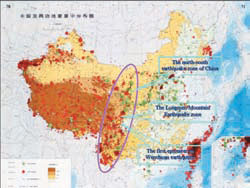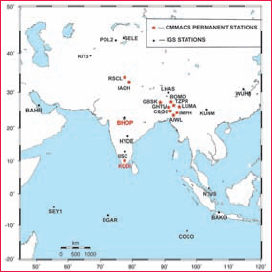Articles in the Mycoordinates Category
China is set to prove its determination for rapid development.
Olympic is not the sole reason but is otherwise also.
It seems to be backed by a vision and action plans.
One one hand we can see the massive infrastructure …

An earthquake, measured 8.0 on the Richter scale, struck Wenchuan County, Sichuan Province at 14:28 on May 12, 2008. The epicenter was at Yingxiu, a town in Wenchuan, as shown in Figure 1. As indicated in Figure 1, the middle segment of the Longmen Mountain earthquake zone encloses the epicenter, Yingxiu, with the Longmen Mountain zone being part of the north-south earthquake zone in China. According to records, there have been 9 earthquakes larger than a grade of 8 occurring in the north-south earthquake zone from 1739, and 7 of them were after 1897, when the greatest one was at Haiyun in 1920 and at Chayu in 1950, both of them measured 8.5.

Small and medium scale maps 1:50,000 up to 1:10,000 (possibly 1:5,000 in near future) at most can be replaced by High Resolution Satellite Imagery (HRSI), though we need ground survey of many objects which cannot interpreted from the HRSI. I agree that the cost performance to produce the smaller scale maps with HRSI would be much higher as compared with aerial photogrammetry if the cost of HRSI is not much high…
The soaring food price in recent months has been unprecedented.
Increased food prices could lead to increased poverty and unrest.
Even, UN call …
It is a demonstration once again.
Rather, an assertion of capabilities and underlying pride.
ISRO’s Polar Satellite Launch Vehicle,
PSLV-C9, successfully launched ten satellites
together, perhaps the highest payload ever.
…

Navigational regionalism
Global Navigational Systems could have served the globe.
However, regions have specific needs.
Moreover, aspirations.
Aspirations to own and control the technology.
Owning makes sense as it adds to the might.
The desire and importance of ‘being mighty’ cannot be undermined.
So the pace for regionalism in navigation system may increase.
Still, they may work in cooperation. Hopefully.
…

RECENTadvances in information and communication technology (ICT)
have resulted in a changing environment with many interdependencies between organizations. There are various data services produced and consumed within the process of enhancement of pipelines project. This happens along the various phases; feasibility study, land allocation, execution and operation. Problems in data sharing arise from the fact that data services are not properly documented resulting in difficulties in updating data, data duplication and long administrative inter–organisational procedures[1]. This article presents a method for elaborating the trade-off between existing situation and the desired future in case of improving conditional data sharing.

This mega thrust earthquake of Dec 26, 2004 shifted several sites on Indian and Eurasian plates, which has been quantified from various GPS studies. As the relative change in triangular area between different sites is more sensitive than the relative change in their coordinates, it has been attempted to calculate the anomalies in triangular area on daily basis between 12 permanent GPS stations of C-MMACS and 16 IGS stations for a period of 60 days from 1st Dec 2004 – 30th Jan 2005.












 (5.00 out of 5)
(5.00 out of 5)